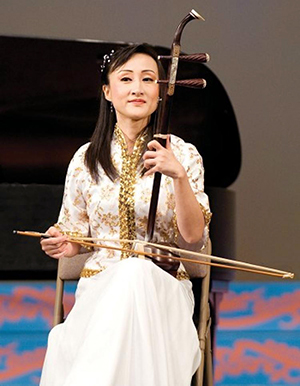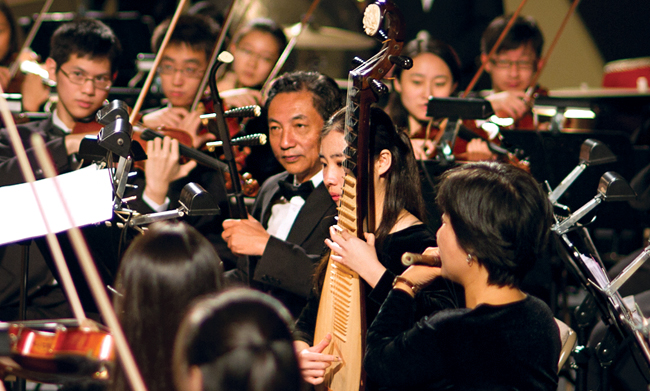This fall, the newest phenomenon in classical music is coming to concert halls across the United States.
For seven seasons, Shen Yun Performing Arts has brought the beauty of China’s five millennia rich culture to spectators around the globe. Shen Yun’s orchestra is especially unique in that it blends Western classical instruments with Eastern melodies producing and distinct and exotic new sound. Many audience members had said that for them, hearing it only in the role of accompaniment was not nearly enough.
International Debut
And so the producers of Shen Yun decided to let the orchestra shine on it’s own stage. In 2012, Shen Yun’s touring orchestras came together at Carnegie Hall for a single grand performance. The magical melodies that audiences knew and loved rose from the orchestra pit to take center stage. The Shen Yun Symphony Orchestra was born.
Starting this month, Shen Yun Symphony Orchestra returns to Carnegie and six other top U.S. halls led by a round of principal conductors Milen Nachev, Leif Sunstrup, Keng Wei Kuo, and Yohei Sato. Mr. Sunstrup was a former conductor with the Sydney Symphony Orchestra and artistic director of the National Symphony Orchestra of Australia. Mr. Sato comes by way of the Boston Conservatory. Whereas Mr. Kuo brings extensive Eastern musical training from Taiwan, rounding out the group is Mr. Nachev, former principal of the Bulgarian National Radio Symphony and a conductor about whom Teatro Colon said, “Impressed the hall by the firmness of his gesture, his command and control of the orchestra.”
What to Expect
The concert will likely begin with a telling of the grand history of China, and evolve into an insightful essay on the China of today, but also look for some your classical favorites and a few surprises along the way.
Shen Yun’s has truly achieved something no other orchestra has: the consummate union of Eastern and Western musical traditions. Alongside Western strings, woodwinds, and brass, the orchestra features ancient Chinese instruments like the erhu, pipa, and a range of percussion.
“Shen Yun’s performance revolves around classical Chinese dance and ethnic styles, and our music is tailored to these rhythms,” said Shen Yun composer Junyi Tan. “To get the ethnic feel just right, there’s nothing better than using Chinese instruments like the erhu and pipa.”

Introducing the Erhu, magical emotive instrument from the East
Amidst the impressive assemblage of instruments that will take the stage, one instrument truly has the power to captivate the heart. The sound of the erhu has been described as, “The mouth of a river pouring out,” and “If the violin is the voice of the star soprano on stage, the erhu is her crying you her life story in a quiet café.”
Its slender body rests upon the seated performer’s lap. Her right hand wields a bamboo bow, forever fixed between its two strings. Her left hand dances along a hardwood neck, traversing invisible intervals to and fro.
This is the erhu (“are-who”), an instrument with a history of over 4,000 years. Throughout the dynasties, the erhu was an integral part of imperial banquets, local operas, and national orchestras.
Despite its simple construction, the erhu is extraordinarily expressive. Having no fingerboard, it allows for an array of vibratos and slides; and without frets, it has great tonal flexibility.
The Erhu’s Many Voices
In the hands of a master, the erhu transforms into a vehicle of joy, sorrow, grace, or tenderness. This two-stringed “Chinese violin” can imitate animal calls and is considered most capable of mimicking the human voice.
“It’s a distinct sound,” said Kerry Stratton, conductor of the Toronto Concert Orchestra, who watched Shen Yun perform in Canada. “The erhu has such a plaintive, human-voice quality to it.”
Shen Yun’s erhu virtuoso Xiaochun Qi will take her seat directly in front of the conductor’s podium. Qi’s bond with the erhu began in China at age six under the tutorage of a devoted father. She went on to graduate from the Shanghai Conservatory of Music and star in international erhu competitions.
"I am completely enchanted,” said Her Royal Highness Princess Michael of Kent after watching her perform at the London Coliseum. “I do hope there is a recording of your wonderful erhu player.”
A sample of her erhu sound is available on Shen Yun’s website (Symphony.ShenYun.com)—the opening bars of Ladies of the Manchu Court. Nothing, however, compares to hearing the erhu live.
Ms. Qi explains, “Anyone can acquire technique,” she says, “but after a certain level, what really touches the audience is the inner meaning behind the music. When we become purer and more serene, the music’s essence is enhanced by divine forces. And that’s what the audience hears.”
What perhaps explains the sublimity of a Shen Yun performance is their passion for reviving a lost heritage and a devotion to positive energy—all of which should be in full display starting tonight at Washington DC's Kennedy Center and continuing for only a few weeks. It promises to be a performance that invigorates and inspires.
2013 Touring Cities
- Sept 27Washington DC Tickets | Info
- Oct 5New York Tickets | Info
- Oct 9Boston Tickets | Info
- Oct 13Houston Tickets | Info
- Oct 15Dallas Tickets | Info
- Oct 18-19Los Angeles Tickets | Info
- Oct 22San Francisco Tickets | Info



